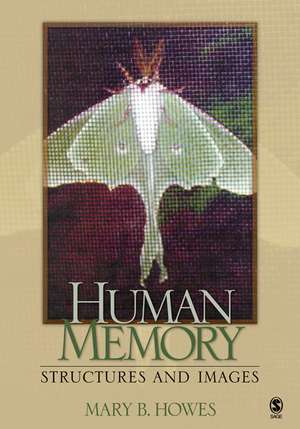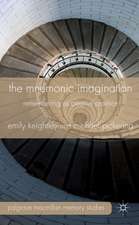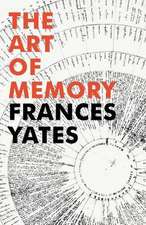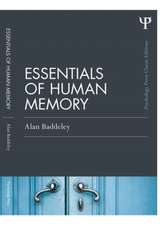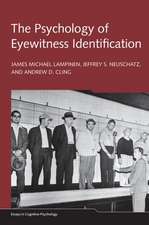Human Memory: Structures and Images
Autor Mary B. Howesen Limba Engleză Paperback – 17 ian 2007
- Offers extensive coverage of naturalistic research: Areas of current naturalistic research, such as eyewitness testimony and courtroom procedures are included, as is the functioning of memory under atypical or abnormal conditions.
The book also discusses the issue of traumatic and repressed memories. In addition, experimental research, including simulation with computers is covered and an appendix on Computer Functioning is available online.
Emphasizes the constructivist position: offering greater coverage than other books on the subject, this text stresses constructivist ideas and examines the debate between constructivist and nonconstructivist models of memory so that readers can emerge with a clear understanding of the issues underlying this opposition.
Provides historical material needed to properly understand current work: A prologue introduces students to the nature of human memory, and a concluding epilogue integrates themes and issues such as strong recall, forgetting, memory change, and false memories from the book in a ôbig pictureö sort of way.
Key terms are highlighted within the text and chapters end with brief summaries and discussion questions.
Intended Audience:
This text is designed for advanced undergraduate and graduate courses such as Memory, Human Memory, Memory and Cognition, and Memory and Forgetting.
Preț: 924.60 lei
Preț vechi: 1016.04 lei
-9% Nou
Puncte Express: 1387
Preț estimativ în valută:
176.92€ • 192.78$ • 149.08£
176.92€ • 192.78$ • 149.08£
Carte tipărită la comandă
Livrare economică 23 aprilie-07 mai
Preluare comenzi: 021 569.72.76
Specificații
ISBN-13: 9781412916295
ISBN-10: 1412916291
Pagini: 472
Dimensiuni: 178 x 254 x 24 mm
Greutate: 0.8 kg
Ediția:1
Editura: SAGE Publications
Colecția Sage Publications, Inc
Locul publicării:Thousand Oaks, United States
ISBN-10: 1412916291
Pagini: 472
Dimensiuni: 178 x 254 x 24 mm
Greutate: 0.8 kg
Ediția:1
Editura: SAGE Publications
Colecția Sage Publications, Inc
Locul publicării:Thousand Oaks, United States
Recenzii
"Human Memory is an important text in memory science. It is expansive and in-depth, covering topics of theoretical importance and practical implication. The complete coverage allows a professor to teach the important theory that all students must be familiar with as well as many of the most contemporary issues in memory science."
"Human Memory is truly comprehensive. It covers the essentials of memory as well as many theoretical perspectives. I look forward to assigning this book to my Learning and Memory class."
"Human Memory is truly comprehensive. It covers the essentials of memory as well as many theoretical perspectives. I look forward to assigning this book to my Learning and Memory class."
Cuprins
Preface: An Introduction to the Nature of Human Memory
1. Memory: Historical and Current Perspectives
The Classic Model of Memory: Aristotle
Empiricism
Rationalism
Constructivism
Computer Models
The Study of Memory
Methodology and Research Traditions
Summary
2. Mainstream Foundations: The Associative Model of Memory
Ebbinghaus: Origins of the Associative Model
The Verbal Learning Tradition
List Learning and Serial Recall Curves
Interference Theory
Consolidation Theory
The Classic Associative Tradition
Interference Theory 1940s-1980s
Summary
Discussion
3. Sensory Memory
The Information Processing Tradition
Sensory Memory: General Properties
Masking
Output Interference
Echoic Memory
Summary
Discussion
4. Verbal Short-Term Memory
General Properties of Verbal Short-Term Memory
Codes in Verbal STM
Word Length
The Events that Occur When Information Enters Verbal STM
Forgetting in Verbal STM
Factors that Eliminate or Diminish Short-Term Forgetting
Cues and Verbal STM
Research Into Manipulations that Influence STM Recall
Models of Verbal Short-Term Memory
Summary
Discussion
5. Working Memory
Attention and Working Memory
Emergence of the Concept of Working Memory from Short-Term Memory
Models of Working Memory: Structural Assumptions
Capacity Theories of Working Memory
Working Memory as Strongly Activated Content
Working Memory in ACT
Loss of Information from WM: Ongoing Research
A Cueing Model of WM
WM as Attentional Capacity
The Genevan View
Inhibition of Unwanted Material
Domain-Specific Versus General Capacity Assumptions
WM and Phenomenological Experience
Summary
Discussion
6. Long-Term Memory: Foundations
Memory Stores
Spread of Encoding Versus Meaningfulness
Entry of Information into LTM
Retrieval of Information from LTM: Cues
Separate Memory Stores for Different Kinds of Information
Encoding Specificity
Single-Stage and Two-Stage Models of Retrieval
Recognition Memory
Signal Detection Theory
Summary
Discussion
7. Long-Term Memory: Ongoing Research
Spreading Activation Models
Propositional Coding: The Representation of Semantic Content
Secondary Cues, Recursive Processing, and Ecphory
Cyclical Retrieval/Global Memory Models
Priming and Spreading Activation Models
False Memory for Word Items
Context and Memory
Output Interference in LTM
Summary
Discussion
8. Constructivism
Constructivism: Basic Tenets
Bartlett
Piaget: The Genevan View
Constructivism in Mainstream Psychology
Summary
9. Memory Change: Alterations in the Components of a Memory
Postevent Information and Memory Change
Nonconstructivist Models of Memory Change
Constructivist Models of Memory Change
Research Data Relating to Constructivist and Nonconstructivist Models
Is Incorrect Information Incorporated into the Experienced Memory
Source Monitering
Inference and Suggestion in Eyewitness Recollection
Memory for Faces
Eyewitness and Investigative Procedures
Emotion and Eyewitness Testimony
Summary
Discussion
10. Long-Term Memory: Higher Order Structures
Inferences
Spatial Contexts
Context Effects: A Thoery of Spatial Relations, Motions, and Constraint
Mental Models
Story Schemas
Schank's Model of Knowledge Structures and Goal-Based Theory
Kintsch's Model of Prose Comprehension
Inferences, the Situation Model, and Knowledge Structures: Ongoing Research
What Inferences are Generated in Natural Text Comprehension?
Summary
Discussion
11. Autobiographical Memory
First Recollections
Causes of Childhood Amnesia
Fragment Memories
The Nature of Autobiographical Memory
Hierarchical Structure in Autobiographical Memory
Access and Retrieval in Autobiographical Memory
Accuracy and Distortion in Adult Recall
Goals, Perspective, and Meaning
Positive and Negative Affect in Episodic Memory
The Nature of Flashbulb Memory
Summary
Discussion
12. Memory for Images
The Strength of Visual Memory
Weakness of Visual Memory
The Debate Over Coding
Propositional Versus Analog Codes: The Experimental Research
Neuroimaging Studies
Perception and Memory Images: Deployment of the Same Neural Structures
Kosslyn's Theory of Image Generation
Eidetic Imagery
Hypermnesia
13. Implicit Memory
Perceptual and Semantic Priming
Implicit Memory: Major Issues
Structural/Activation Theory
Processing/Episodic Models of Priming
Unconscious Perception and Priming
Interference in Implicit Memory
Implicit Memory as a Separate Memory System
Priming as Transfer of Processing
Associative Learning
Monitoring of Frequency and Temporal Information
Complex Associative Learning
Implicit Processing and Emotion
Summary
Discussion
14. Traumatic Memory and False Memory
Memory and PTSD
Controlled Observational Research
Repression, Dissociation, and Consolidation Failure
An Epidemic of Recovered Memories
Satanic Rituals
Individuals Accused of Child Abuse
Recovered Memories: Empirical Findings
Trauma Associated with Incarceration: Memories of Concentration Camp Survivors
Memories of Crimes and Disasters
False Memories in Natural Contexts
False Memories in Young Children
Hypnosis and Memory
Summary
Discussion
15. Disorders of Memory
The Amnesic Syndrome
The Amnesic Syndrome: Theoretical Models
Deficit in Short-Term Recall
Frontal Lobe Damage
Loss of Memory for Selective Information
Reduplicative Paramnesia and Capgras Syndrome
Remediation
Memory and Aging
Dementia
Summary
Discussion
16. Neuroscience and Memory
The Neuron
The Human Brain
Neuroimaging Techniques
Memory Content and Distributed Processing
Strcutures that Mediate Memory
Memory Functions and Brain Structures: Neuroimaging Data
Storage of Declarative Memory Content: Perceptual Structures
Function and Location
Emotion and Memory
Intermediate Memory
17. Afterword
Why Do We Forget?
The Status of Information Coded on LTM
Meaning Codes and Higher Order Structures
Memory Change
Memories
Discussion
1. Memory: Historical and Current Perspectives
The Classic Model of Memory: Aristotle
Empiricism
Rationalism
Constructivism
Computer Models
The Study of Memory
Methodology and Research Traditions
Summary
2. Mainstream Foundations: The Associative Model of Memory
Ebbinghaus: Origins of the Associative Model
The Verbal Learning Tradition
List Learning and Serial Recall Curves
Interference Theory
Consolidation Theory
The Classic Associative Tradition
Interference Theory 1940s-1980s
Summary
Discussion
3. Sensory Memory
The Information Processing Tradition
Sensory Memory: General Properties
Masking
Output Interference
Echoic Memory
Summary
Discussion
4. Verbal Short-Term Memory
General Properties of Verbal Short-Term Memory
Codes in Verbal STM
Word Length
The Events that Occur When Information Enters Verbal STM
Forgetting in Verbal STM
Factors that Eliminate or Diminish Short-Term Forgetting
Cues and Verbal STM
Research Into Manipulations that Influence STM Recall
Models of Verbal Short-Term Memory
Summary
Discussion
5. Working Memory
Attention and Working Memory
Emergence of the Concept of Working Memory from Short-Term Memory
Models of Working Memory: Structural Assumptions
Capacity Theories of Working Memory
Working Memory as Strongly Activated Content
Working Memory in ACT
Loss of Information from WM: Ongoing Research
A Cueing Model of WM
WM as Attentional Capacity
The Genevan View
Inhibition of Unwanted Material
Domain-Specific Versus General Capacity Assumptions
WM and Phenomenological Experience
Summary
Discussion
6. Long-Term Memory: Foundations
Memory Stores
Spread of Encoding Versus Meaningfulness
Entry of Information into LTM
Retrieval of Information from LTM: Cues
Separate Memory Stores for Different Kinds of Information
Encoding Specificity
Single-Stage and Two-Stage Models of Retrieval
Recognition Memory
Signal Detection Theory
Summary
Discussion
7. Long-Term Memory: Ongoing Research
Spreading Activation Models
Propositional Coding: The Representation of Semantic Content
Secondary Cues, Recursive Processing, and Ecphory
Cyclical Retrieval/Global Memory Models
Priming and Spreading Activation Models
False Memory for Word Items
Context and Memory
Output Interference in LTM
Summary
Discussion
8. Constructivism
Constructivism: Basic Tenets
Bartlett
Piaget: The Genevan View
Constructivism in Mainstream Psychology
Summary
9. Memory Change: Alterations in the Components of a Memory
Postevent Information and Memory Change
Nonconstructivist Models of Memory Change
Constructivist Models of Memory Change
Research Data Relating to Constructivist and Nonconstructivist Models
Is Incorrect Information Incorporated into the Experienced Memory
Source Monitering
Inference and Suggestion in Eyewitness Recollection
Memory for Faces
Eyewitness and Investigative Procedures
Emotion and Eyewitness Testimony
Summary
Discussion
10. Long-Term Memory: Higher Order Structures
Inferences
Spatial Contexts
Context Effects: A Thoery of Spatial Relations, Motions, and Constraint
Mental Models
Story Schemas
Schank's Model of Knowledge Structures and Goal-Based Theory
Kintsch's Model of Prose Comprehension
Inferences, the Situation Model, and Knowledge Structures: Ongoing Research
What Inferences are Generated in Natural Text Comprehension?
Summary
Discussion
11. Autobiographical Memory
First Recollections
Causes of Childhood Amnesia
Fragment Memories
The Nature of Autobiographical Memory
Hierarchical Structure in Autobiographical Memory
Access and Retrieval in Autobiographical Memory
Accuracy and Distortion in Adult Recall
Goals, Perspective, and Meaning
Positive and Negative Affect in Episodic Memory
The Nature of Flashbulb Memory
Summary
Discussion
12. Memory for Images
The Strength of Visual Memory
Weakness of Visual Memory
The Debate Over Coding
Propositional Versus Analog Codes: The Experimental Research
Neuroimaging Studies
Perception and Memory Images: Deployment of the Same Neural Structures
Kosslyn's Theory of Image Generation
Eidetic Imagery
Hypermnesia
13. Implicit Memory
Perceptual and Semantic Priming
Implicit Memory: Major Issues
Structural/Activation Theory
Processing/Episodic Models of Priming
Unconscious Perception and Priming
Interference in Implicit Memory
Implicit Memory as a Separate Memory System
Priming as Transfer of Processing
Associative Learning
Monitoring of Frequency and Temporal Information
Complex Associative Learning
Implicit Processing and Emotion
Summary
Discussion
14. Traumatic Memory and False Memory
Memory and PTSD
Controlled Observational Research
Repression, Dissociation, and Consolidation Failure
An Epidemic of Recovered Memories
Satanic Rituals
Individuals Accused of Child Abuse
Recovered Memories: Empirical Findings
Trauma Associated with Incarceration: Memories of Concentration Camp Survivors
Memories of Crimes and Disasters
False Memories in Natural Contexts
False Memories in Young Children
Hypnosis and Memory
Summary
Discussion
15. Disorders of Memory
The Amnesic Syndrome
The Amnesic Syndrome: Theoretical Models
Deficit in Short-Term Recall
Frontal Lobe Damage
Loss of Memory for Selective Information
Reduplicative Paramnesia and Capgras Syndrome
Remediation
Memory and Aging
Dementia
Summary
Discussion
16. Neuroscience and Memory
The Neuron
The Human Brain
Neuroimaging Techniques
Memory Content and Distributed Processing
Strcutures that Mediate Memory
Memory Functions and Brain Structures: Neuroimaging Data
Storage of Declarative Memory Content: Perceptual Structures
Function and Location
Emotion and Memory
Intermediate Memory
17. Afterword
Why Do We Forget?
The Status of Information Coded on LTM
Meaning Codes and Higher Order Structures
Memory Change
Memories
Discussion
Notă biografică
Mary B. Howes received her Ph.D. in 1979 from New York University with a concentration in Cognition. She specializes in cognitive psychology with particular emphasis on early memory. She teaches courses on statistics, cognition, and memory and is author of the text "The Psychology of Human Cognition: Mainstream and Genevan Traditions" (Allyn & Bacon 1990).
Descriere
Human Memory: Structures and Images offers students a comprehensive overview of research in human memory. Providing a theoretical background for the research, author Mary B. Howes uses a clear and accessible format to cover three major areas—mainstream experimental research; naturalistic research; and work in the domains of the amnesias, malfunctions of memory, and neuroscience.
